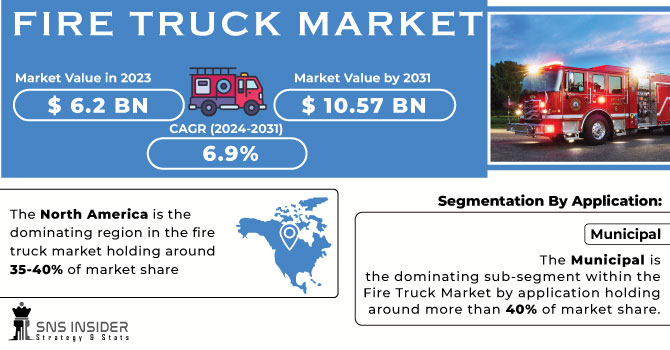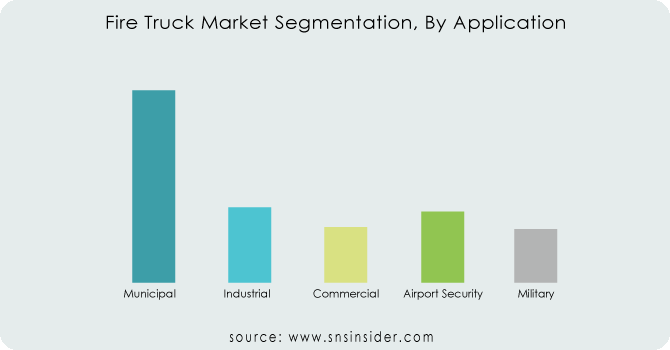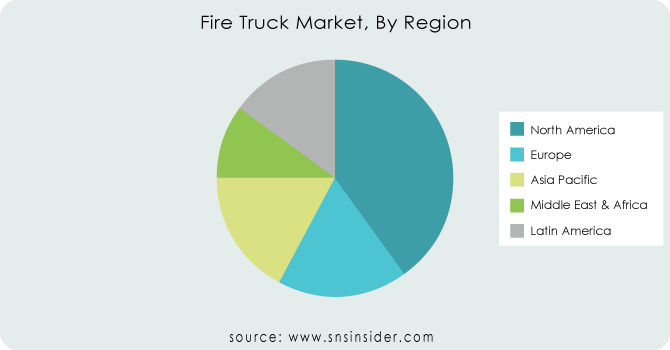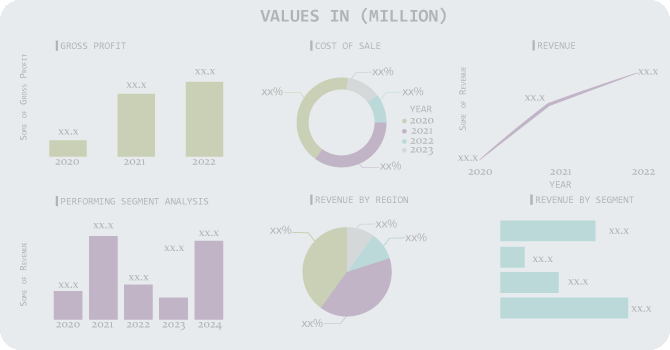The Fire Truck Market Size was valued at USD 6.2 billion in 2023 and is expected to reach USD 10.57 billion by 2031 and grow at a CAGR of 6.9% over the forecast period 2024-2031.
The fire truck market is poised for growth driven by urbanization, stricter fire safety regulations, and technological advancements. As cities become more crowded, the risk of larger fires increases. This creates a demand for modern fire trucks that can handle these complex situations. Governments around the world are implementing stricter fire codes, mandating features like improved pumping capacities, enhanced ladder capabilities, and advanced firefighting technologies on fire trucks.

Get More Information on Fire Truck Market - Request Sample Report
The integration of aerial ladder platforms with automated deployment systems allows for faster and safer access to higher floors during building fires. The fire trucks are incorporating thermal imaging cameras to help firefighters locate victims and navigate smoke-filled environments. These advancements enhance firefighter safety and firefighting efficiency, leading to increased demand for such equipped trucks.
The high initial cost of fire trucks, particularly those with advanced features, can be a barrier for some fire departments, especially in budget-constrained regions.
KEY DRIVERS:
Stricter fire safety regulations are pushing fire departments to upgrade their trucks with advanced features.
The increasing awareness of fire safety is driving demand for better firefighting technology.
Advancements in firefighting technology like thermal cameras lead to development of more effective fire trucks.
The fire truck market is undergoing a transformation fueled by advancements in firefighting technology. One key driver is the integration of thermal imaging cameras. These cameras pierce through smoke and darkness, allowing firefighters to see what the human eye cannot. The firefighters can locate victims trapped in smoke-filled buildings more quickly and efficiently. The thermal cameras help pinpoint the hottest areas of the fire, enabling firefighters to target their water streams more precisely. This not only conserves water but also minimizes damage caused by excessive water use. Furthermore, thermal imaging allows firefighters to identify hidden pockets of fire that might otherwise reignite later, preventing flare-ups and ensuring a safer environment for everyone involved. The development and use of these advanced technologies are making fire trucks more effective tools for saving lives and property.
RESTRAINTS:
Maintenance costs for complex fire trucks with advanced technology can be a burden for some departments.
Modern fire trucks equipped with complex features like thermal cameras, advanced pumping systems, and computer-aided controls require specialized knowledge and training for technicians to maintain and repair. This can be a burden for smaller departments with limited resources. Not only does it necessitate investment in specialized training programs for their personnel, but it may also require outsourcing maintenance to qualified technicians, adding to the overall operational costs. The sophisticated technology can also lead to the need for more specialized parts and equipment, potentially increasing maintenance costs further.
Limited government funding for fire departments in some regions can restrict their ability to invest in the latest fire trucks.
OPPORTUNITIES:
Increasing focus on firefighter safety can lead to development of fire trucks with advanced safety features like improved cabin protection and firefighter monitoring systems.
Growing demand for specialized fire trucks in areas like electric vehicle fires and natural disasters can open new market segments.
CHALLENGES:
The long lifespan of fire trucks due to their durability can slow down adoption of new technologies.
By Type
Rescue Truck
Tanker
Pumper
Multi-Tasking Truck
Aerial Ladder
ARFF
Specialty Vehicles
Pumper is the dominating sub-segment in the Fire Truck Market by type holding around 40-45% of market share. This dominance is driven by their versatility and core firefighting functionality. Pumper trucks carry large water tanks and powerful pumps, allowing them to be the primary fire attack vehicle for most fire departments. Their ability to deliver high volumes of water quickly and efficiently makes them crucial for extinguishing a wide range of fires. While other specialized trucks play important roles, pumper trucks remain the backbone of most firefighting fleets due to their adaptability and essential firefighting capabilities.
By Application
Municipal
Industrial
Commercial
Airport Security
Military
The municipal is the dominating sub-segment within the Fire Truck Market by application holding around more than 40% of market share. Municipal fire departments are responsible for protecting the majority of the population and respond to the widest range of fire emergencies. This necessitates a diverse fleet that includes pumper trucks, ladder trucks, rescue vehicles, and other specialized units. The high concentration of people and structures in urban areas creates a constant demand for well-equipped municipal fire departments, driving the dominance of this segment.

Get Customized Report as per Your Business Requirement - Request For Customized Report
The North America is the dominating region in the fire truck market holding around 35-40% of market share, fueled by the well-funded fire departments and strict fire safety regulations. These regulations mandate advanced features and frequent upgrades, necessitating consistent investment in modern fire trucks.
The Asia-Pacific is the fastest growing region in this market. This surge is driven by rapid urbanization and industrialization, leading to a heightened demand for advanced fire protection. Rising fire safety awareness across Asia is prompting governments to invest in modern fire trucks for improved response times. The presence of cost-competitive Chinese manufacturers makes fire trucks more accessible for regional fire departments, further accelerating market growth in Asia-Pacific.

REGIONAL COVERAGE:
North America
US
Canada
Mexico
Europe
Eastern Europe
Poland
Romania
Hungary
Turkey
Rest of Eastern Europe
Western Europe
Germany
France
UK
Italy
Spain
Netherlands
Switzerland
Austria
Rest of Western Europe
Asia Pacific
China
India
Japan
South Korea
Vietnam
Singapore
Australia
Rest of Asia Pacific
Middle East & Africa
Middle East
UAE
Egypt
Saudi Arabia
Qatar
Rest of the Middle East
Africa
Nigeria
South Africa
Rest of Africa
Latin America
Brazil
Argentina
Colombia
Rest of Latin America
The major key players are Rosenbauer International AG (Austria), Oshkosh Corporation (Japan), Zoomlion Heavy Industry Science & Technology Co., Ltd., (China), Alexis Fire Equipment Company (USA), MORITA Holdings Corporation (Japan), W. S. Darley & Co. (USA), ALBERT ZIEGLER GmbH (Germany), KME Corp. (USA), Spartan Motors (USA), Magirus GmbH (Germany) and other key players.

In April 2023: E-ONE's new Defender Type III fire truck tackles tough situations. Designed for urban-interface firefighting, it boasts a low battery placement for increased stability during operation, ensuring firefighters can maneuver confidently even in challenging environments.
| Report Attributes | Details |
|---|---|
| Market Size in 2023 | US$ 6.2 Billion |
| Market Size by 2031 | US$ 10.57 Billion |
| CAGR | CAGR of 6.9% From 2024 to 20231 |
| Base Year | 2023 |
| Forecast Period | 2024-2031 |
| Historical Data | 2020-2022 |
| Report Scope & Coverage | Market Size, Segments Analysis, Competitive Landscape, Regional Analysis, DROC & SWOT Analysis, Forecast Outlook |
| Key Segments | • by Type (Rescue Trucks, Tanker, Pumper, Multi-tasking Trucks) • by Application (Residential & Commercial, Enterprises & Airports, Military) |
| Regional Analysis/Coverage | North America (US, Canada, Mexico), Europe (Eastern Europe [Poland, Romania, Hungary, Turkey, Rest of Eastern Europe] Western Europe] Germany, France, UK, Italy, Spain, Netherlands, Switzerland, Austria, Rest of Western Europe]), Asia Pacific (China, India, Japan, South Korea, Vietnam, Singapore, Australia, Rest of Asia Pacific), Middle East & Africa (Middle East [UAE, Egypt, Saudi Arabia, Qatar, Rest of Middle East], Africa [Nigeria, South Africa, Rest of Africa], Latin America (Brazil, Argentina, Colombia, Rest of Latin America) |
| Company Profiles | Rosenbauer International AG (Austria), Oshkosh Corporation (Japan), Zoomlion Heavy Industry Science & Technology Co., Ltd., (China), Alexis Fire Equipment Company (USA), MORITA Holdings Corporation (Japan), W. S. Darley & Co. (USA), ALBERT ZIEGLER GmbH (Germany), KME Corp. (USA), Spartan Motors (USA), and Magirus GmbH (Germany) |
| Key Drivers | • Increased worldwide interest in fire safety. • The market is growing as a result of the. increasing demand for cutting-edge firefighting equipment. |
| RESTRAINTS | • Engine manufacturing's rapid expansion has been slowed by the industry's expensive start-up expenses. • Low replacement rates and a lack of necessary equipment for the development of fire engines. |
Ans:- The Fire Truck Market size is expected to reach USD 6.2 billion by 2023.
Ans:- North American region is anticipated to be the primary driver of the market.
Ans:- Increase in airport and business safety infrastructure and advanced technologies improve teamwork & quality are the most promising aspects/opportunities of the fire truck market.
Ans:- Yes.
Ans:- The study includes a comprehensive analysis of market trends, as well as present and future market forecasts. DROC analysis, as well as impact analysis for the projected period. Porter’s five forces analysis aids in the study of buyer and supplier potential as well as the competitive landscape etc.
TABLE OF CONTENTS
1. Introduction
1.1 Market Definition
1.2 Scope
1.3 Research Assumptions
2. Industry Flowchart
3. Research Methodology
4. Market Dynamics
4.1 Drivers
4.2 Restraints
4.3 Opportunities
4.4 Challenges
5. Porter’s 5 Forces Model
6. Pest Analysis
7. Fire Truck Market Segmentation, By Type
7.1 Introduction
7.2 Rescue Truck
7.3 Tanker
7.4 Pumper
7.5 Multi-Tasking Truck
7.6 Aerial Ladder
7.7 ARFF
7.8 Specialty Vehicles
8. Fire Truck Market Segmentation, By Application
8.1 Introduction
8.2 Municipal
8.3 Industrial
8.4 Commercial
8.5 Airport Security
8.6 Military
9. Regional Analysis
9.1 Introduction
9.2 North America
9.2.1 Trend Analysis
9.2.2 North America Fire Truck Market, By Country
9.2.3 North America Fire Truck Market Segmentation, By Type
9.2.4 North America Fire Truck Market Segmentation, By Application
9.2.5 USA
9.2.5.1 USA Fire Truck Market Segmentation, By Type
9.2.5.2 USA Fire Truck Market Segmentation, By Application
9.2.6 Canada
9.2.6.1 Canada Fire Truck Market Segmentation, By Type
9.2.6.2 Canada Fire Truck Market Segmentation, By Application
9.2.7 Mexico
9.2.7.1 Mexico Fire Truck Market Segmentation, By Type
9.2.7.2 Mexico Fire Truck Market Segmentation, By Application
9.3 Europe
9.3.1 Trend Analysis
9.3.2 Eastern Europe
9.3.2.1 Eastern Europe Fire Truck Market, By Country
9.3.2.2 Eastern Europe Fire Truck Market Segmentation, By Type
9.3.2.3 Eastern Europe Fire Truck Market Segmentation, By Application
9.3.2.4 Poland
9.3.2.4.1 Poland Fire Truck Market Segmentation, By Type
9.3.2.4.2 Poland Fire Truck Market Segmentation, By Application
9.3.2.5 Romania
9.3.2.5.1 Romania Fire Truck Market Segmentation, By Type
9.3.2.5.2 Romania Fire Truck Market Segmentation, By Application
9.3.2.6 Hungary
9.3.2.6.1 Hungary Fire Truck Market Segmentation, By Type
9.3.2.6.2 Hungary Fire Truck Market Segmentation, By Application
9.3.2.7 Turkey
9.3.2.7.1 Turkey Fire Truck Market Segmentation, By Type
9.3.2.7.2 Turkey Fire Truck Market Segmentation, By Application
9.3.2.8 Rest of Eastern Europe
9.3.2.8.1 Rest of Eastern Europe Fire Truck Market Segmentation, By Type
9.3.2.8.2 Rest of Eastern Europe Fire Truck Market Segmentation, By Application
9.3.3 Western Europe
9.3.3.1 Western Europe Fire Truck Market, By Country
9.3.3.2 Western Europe Fire Truck Market Segmentation, By Type
9.3.3.3 Western Europe Fire Truck Market Segmentation, By Application
9.3.3.4 Germany
9.3.3.4.1 Germany Fire Truck Market Segmentation, By Type
9.3.3.4.2 Germany Fire Truck Market Segmentation, By Application
9.3.3.5 France
9.3.3.5.1 France Fire Truck Market Segmentation, By Type
9.3.3.5.2 France Fire Truck Market Segmentation, By Application
9.3.3.6 UK
9.3.3.6.1 UK Fire Truck Market Segmentation, By Type
9.3.3.6.2 UK Fire Truck Market Segmentation, By Application
9.3.3.7 Italy
9.3.3.7.1 Italy Fire Truck Market Segmentation, By Type
9.3.3.7.2 Italy Fire Truck Market Segmentation, By Application
9.3.3.8 Spain
9.3.3.8.1 Spain Fire Truck Market Segmentation, By Type
9.3.3.8.2 Spain Fire Truck Market Segmentation, By Application
9.3.3.9 Netherlands
9.3.3.9.1 Netherlands Fire Truck Market Segmentation, By Type
9.3.3.9.2 Netherlands Fire Truck Market Segmentation, By Application
9.3.3.10 Switzerland
9.3.3.10.1 Switzerland Fire Truck Market Segmentation, By Type
9.3.3.10.2 Switzerland Fire Truck Market Segmentation, By Application
9.3.3.11 Austria
9.3.3.11.1 Austria Fire Truck Market Segmentation, By Type
9.3.3.11.2 Austria Fire Truck Market Segmentation, By Application
9.3.3.12 Rest of Western Europe
9.3.3.12.1 Rest of Western Europe Fire Truck Market Segmentation, By Type
9.3.2.12.2 Rest of Western Europe Fire Truck Market Segmentation, By Application
9.4 Asia-Pacific
9.4.1 Trend Analysis
9.4.2 Asia Pacific Fire Truck Market, By Country
9.4.3 Asia Pacific Fire Truck Market Segmentation, By Type
9.4.4 Asia Pacific Fire Truck Market Segmentation, By Application
9.4.5 China
9.4.5.1 China Fire Truck Market Segmentation, By Type
9.4.5.2 China Fire Truck Market Segmentation, By Application
9.4.6 India
9.4.6.1 India Fire Truck Market Segmentation, By Type
9.4.6.2 India Fire Truck Market Segmentation, By Application
9.4.7 Japan
9.4.7.1 Japan Fire Truck Market Segmentation, By Type
9.4.7.2 Japan Fire Truck Market Segmentation, By Application
9.4.8 South Korea
9.4.8.1 South Korea Fire Truck Market Segmentation, By Type
9.4.8.2 South Korea Fire Truck Market Segmentation, By Application
9.4.9 Vietnam
9.4.9.1 Vietnam Fire Truck Market Segmentation, By Type
9.4.9.2 Vietnam Fire Truck Market Segmentation, By Application
9.4.10 Singapore
9.4.10.1 Singapore Fire Truck Market Segmentation, By Type
9.4.10.2 Singapore Fire Truck Market Segmentation, By Application
9.4.11 Australia
9.4.11.1 Australia Fire Truck Market Segmentation, By Type
9.4.11.2 Australia Fire Truck Market Segmentation, By Application
9.4.12 Rest of Asia-Pacific
9.4.12.1 Rest of Asia-Pacific Fire Truck Market Segmentation, By Type
9.4.12.2 Rest of Asia-Pacific Fire Truck Market Segmentation, By Application
9.5 Middle East & Africa
9.5.1 Trend Analysis
9.5.2 Middle East
9.5.2.1 Middle East Fire Truck Market, By Country
9.5.2.2 Middle East Fire Truck Market Segmentation, By Type
9.5.2.3 Middle East Fire Truck Market Segmentation, By Application
9.5.2.4 UAE
9.5.2.4.1 UAE Fire Truck Market Segmentation, By Type
9.5.2.4.2 UAE Fire Truck Market Segmentation, By Application
9.5.2.5 Egypt
9.5.2.5.1 Egypt Fire Truck Market Segmentation, By Type
9.5.2.5.2 Egypt Fire Truck Market Segmentation, By Application
9.5.2.6 Saudi Arabia
9.5.2.6.1 Saudi Arabia Fire Truck Market Segmentation, By Type
9.5.2.6.2 Saudi Arabia Fire Truck Market Segmentation, By Application
9.5.2.7 Qatar
9.5.2.7.1 Qatar Fire Truck Market Segmentation, By Type
9.5.2.7.2 Qatar Fire Truck Market Segmentation, By Application
9.5.2.8 Rest of Middle East
9.5.2.8.1 Rest of Middle East Fire Truck Market Segmentation, By Type
9.5.2.8.2 Rest of Middle East Fire Truck Market Segmentation, By Application
9.5.3 Africa
9.5.3.1 Africa Fire Truck Market, By Country
9.5.3.2 Africa Fire Truck Market Segmentation, By Type
9.5.3.3 Africa Fire Truck Market Segmentation, By Application
9.5.2.4 Nigeria
9.5.2.4.1 Nigeria Fire Truck Market Segmentation, By Type
9.5.2.4.2 Nigeria Fire Truck Market Segmentation, By Application
9.5.2.5 South Africa
9.5.2.5.1 South Africa Fire Truck Market Segmentation, By Type
9.5.2.5.2 South Africa Fire Truck Market Segmentation, By Application
9.5.2.6 Rest of Africa
9.5.2.6.1 Rest of Africa Fire Truck Market Segmentation, By Type
9.5.2.6.2 Rest of Africa Fire Truck Market Segmentation, By Application
9.6 Latin America
9.6.1 Trend Analysis
9.6.2 Latin America Fire Truck Market, By Country
9.6.3 Latin America Fire Truck Market Segmentation, By Type
9.6.4 Latin America Fire Truck Market Segmentation, By Application
9.6.5 Brazil
9.6.5.1 Brazil Fire Truck Market Segmentation, By Type
9.6.5.2 Brazil Fire Truck Market Segmentation, By Application
9.6.6 Argentina
9.6.6.1 Argentina Fire Truck Market Segmentation, By Type
9.6.6.2 Argentina Fire Truck Market Segmentation, By Application
9.6.7 Colombia
9.6.7.1 Colombia Fire Truck Market Segmentation, By Type
9.6.7.2 Colombia Fire Truck Market Segmentation, By Application
9.6.8 Rest of Latin America
9.6.8.1 Rest of Latin America Fire Truck Market Segmentation, By Type
9.6.8.2 Rest of Latin America Fire Truck Market Segmentation, By Application
10. Company Profiles
10.1 Rosenbauer International AG (Austria)
10.1.1 Company Overview
10.1.2 Financial
10.1.3 Products/ Services Offered
10.1.4 The SNS View
10.2 Oshkosh Corporation (Japan)
10.2.1 Company Overview
10.2.2 Financial
10.2.3 Products/ Services Offered
10.2.4 The SNS View
10.3 Zoomlion Heavy Industry Science & Technology Co., Ltd., (China)
10.3.1 Company Overview
10.3.2 Financial
10.3.3 Products/ Services Offered
10.3.4 The SNS View
10.4 Alexis Fire Equipment Company (USA)
10.4.1 Company Overview
10.4.2 Financial
10.4.3 Products/ Services Offered
10.4.4 The SNS View
10.5 MORITA Holdings Corporation (Japan)
10.5.1 Company Overview
10.5.2 Financial
10.5.3 Products/ Services Offered
10.5.4 The SNS View
10.6 W. S. Darley & Co. (USA)
10.6.1 Company Overview
10.6.2 Financial
10.6.3 Products/ Services Offered
10.6.4 The SNS View
10.7 ALBERT ZIEGLER GmbH (Germany)
10.7.1 Company Overview
10.7.2 Financial
10.7.3 Products/ Services Offered
10.7.4 The SNS View
10.8 KME Corp. (USA)
10.8.1 Company Overview
10.8.2 Financial
10.8.3 Products/ Services Offered
10.8.4 The SNS View
10.9 Spartan Motors (USA)
10.9.1 Company Overview
10.9.2 Financial
10.9.3 Products/ Services Offered
10.9.4 The SNS View
10.10 Magirus GmbH (Germany)
10.10.1 Company Overview
10.10.2 Financial
10.10.3 Products/ Services Offered
10.10.4 The SNS View
11. Competitive Landscape
11.1 Competitive Benchmarking
11.2 Market Share Analysis
11.3 Recent Developments
11.3.1 Industry News
11.3.2 Company News
11.3.3 Mergers & Acquisitions
12. USE Cases and Best Practices
13. Conclusion
An accurate research report requires proper strategizing as well as implementation. There are multiple factors involved in the completion of good and accurate research report and selecting the best methodology to compete the research is the toughest part. Since the research reports we provide play a crucial role in any company’s decision-making process, therefore we at SNS Insider always believe that we should choose the best method which gives us results closer to reality. This allows us to reach at a stage wherein we can provide our clients best and accurate investment to output ratio.
Each report that we prepare takes a timeframe of 350-400 business hours for production. Starting from the selection of titles through a couple of in-depth brain storming session to the final QC process before uploading our titles on our website we dedicate around 350 working hours. The titles are selected based on their current market cap and the foreseen CAGR and growth.
The 5 steps process:
Step 1: Secondary Research:
Secondary Research or Desk Research is as the name suggests is a research process wherein, we collect data through the readily available information. In this process we use various paid and unpaid databases which our team has access to and gather data through the same. This includes examining of listed companies’ annual reports, Journals, SEC filling etc. Apart from this our team has access to various associations across the globe across different industries. Lastly, we have exchange relationships with various university as well as individual libraries.

Step 2: Primary Research
When we talk about primary research, it is a type of study in which the researchers collect relevant data samples directly, rather than relying on previously collected data. This type of research is focused on gaining content specific facts that can be sued to solve specific problems. Since the collected data is fresh and first hand therefore it makes the study more accurate and genuine.
We at SNS Insider have divided Primary Research into 2 parts.
Part 1 wherein we interview the KOLs of major players as well as the upcoming ones across various geographic regions. This allows us to have their view over the market scenario and acts as an important tool to come closer to the accurate market numbers. As many as 45 paid and unpaid primary interviews are taken from both the demand and supply side of the industry to make sure we land at an accurate judgement and analysis of the market.
This step involves the triangulation of data wherein our team analyses the interview transcripts, online survey responses and observation of on filed participants. The below mentioned chart should give a better understanding of the part 1 of the primary interview.

Part 2: In this part of primary research the data collected via secondary research and the part 1 of the primary research is validated with the interviews from individual consultants and subject matter experts.
Consultants are those set of people who have at least 12 years of experience and expertise within the industry whereas Subject Matter Experts are those with at least 15 years of experience behind their back within the same space. The data with the help of two main processes i.e., FGDs (Focused Group Discussions) and IDs (Individual Discussions). This gives us a 3rd party nonbiased primary view of the market scenario making it a more dependable one while collation of the data pointers.
Step 3: Data Bank Validation
Once all the information is collected via primary and secondary sources, we run that information for data validation. At our intelligence centre our research heads track a lot of information related to the market which includes the quarterly reports, the daily stock prices, and other relevant information. Our data bank server gets updated every fortnight and that is how the information which we collected using our primary and secondary information is revalidated in real time.

Step 4: QA/QC Process
After all the data collection and validation our team does a final level of quality check and quality assurance to get rid of any unwanted or undesired mistakes. This might include but not limited to getting rid of the any typos, duplication of numbers or missing of any important information. The people involved in this process include technical content writers, research heads and graphics people. Once this process is completed the title gets uploader on our platform for our clients to read it.
Step 5: Final QC/QA Process:
This is the last process and comes when the client has ordered the study. In this process a final QA/QC is done before the study is emailed to the client. Since we believe in giving our clients a good experience of our research studies, therefore, to make sure that we do not lack at our end in any way humanly possible we do a final round of quality check and then dispatch the study to the client.
The Luxury Car Rental Market Size was USD 39.68 Billion in 2023, and is expected to reach USD 78.36 Bn by 2032, and grow at a CAGR of 7.88% by 2024-2032.
The Automotive HUD Market size was valued at USD 1.25 billion in 2023 and will reach USD 5.88 billion by 2032, the estimated CAGR by 2024-2032 is 16.72%
The Vehicle Subscription Market size was valued at USD 4.08 billion in 2023 and is expected to reach USD 142.98 billion by 2032, growing at a CAGR of 48.50% over the forecast period 2024-2032.
The Railway Telematics Market size will reach to USD 20.52 billion by 2032 and will be growing at a CAGR of 6.5% over 2024-2032 & USD 11.64 billion in 2023.
The Automotive Windshield Washer Market Size was USD 20.48 billion in 2023 and will reach USD 30.72 billion by 2031 and grow at a CAGR of 5.2% by 2024-2031
The Automotive Seat Belt Pretensioner Market Size was USD 14.18 Bn in 2023 and expected to reach $25.69 Bn by 2032 & grow at a CAGR of 6.83% by 2024-2032.
Hi! Click one of our member below to chat on Phone